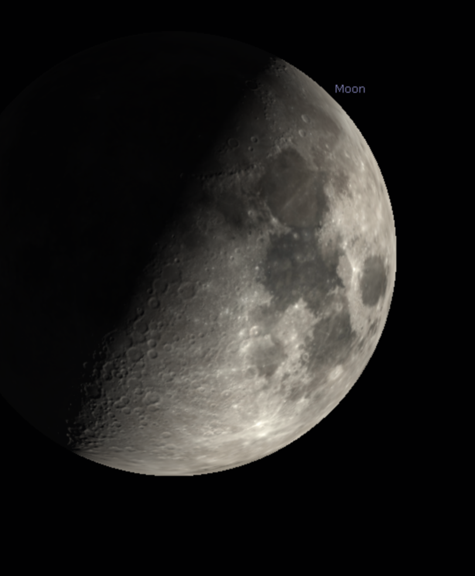What's Up: May 26- June 1, 2023 by Jared May
What’s up this fourth week of May
The forecast is pointing to a poor weekend of stargazing – unless want to risk getting rain in your telescope. First up, however, on Friday night things look gloriously clear. Saturday and Sunday look cloudy and, perhaps, rainy. If you have patience, by Monday night or Tuesday night things should be clearing up again. The upcoming clear nights will be in the mid-60s in the hours following sunset.
This week be on the lookout for the First Quarter Moon, Mercury high in the sky, a Moon-Mars-Venus trio, the M101 supernova, and we might see some deep-sky photos from the balloon-borne telescope, SuperBIT.
Over the past several days you may have been noticing the moon creeping higher and higher in the sky as it is transitioning between its New Moon and First Quarter phase. This Saturday, May 27th, marks the First Quarter Moon. The “early” phases, when the moon isn’t too bright, are an ideal time to do some stargazing. Around these phases is also a great time to look for Earthshine, an effect where the dark side of the moon is slightly visible shortly after sunset from all the light bouncing off the earth and then hitting the moon. This gets harder to do as the moon gets more full.
simulated view of the first quarter moon, as seen on Saturday evening.
Mercury will reach its greatest western elongation this upcoming week meaning it will be at its highest point in the sky (or its apparent farthest distance from the sun as viewed from the Earth). Unfortunately, you can only see Mercury if you’re a morning person. This inner planet is currently leading the sun, so it sets below the horizon before the sun does. In the early morning hours between 5:15 and 5:50 AM, you can see Mercury as a faint star-looking object in the eastern sky several degrees “below” Jupiter.
Mercury and Jupiter as seen in the morning sky just before dawn.
In the evening skies, in addition to the moon, you will see a bright star-like object in the western sky. This object is Venus. Once the sun sets a little more, a careful eye will see a red-colored star-like object nestled between the Moon and Venus. This is Mars. A pair of binoculars will do these planetary neighbors of ours some justice, although a telescope will reveal more details of the planets. You may be able to see what phase Venus is in, or perhaps, if you crank up the telescope to high power, the polar ice caps on Mars.
The locations of Mars, Venus and the moon as seen on Friday
M101 is a face-on spiral galaxy that is among the most popular deep-sky objects for astrophotographers. It is so popular since it is relatively bright and large (although not as much as the Andromeda Galaxy) and because it is face-on. This means that telescopes from Earth can see all of the photogenic spiral arms. Some galaxies are edge-on meaning we are looking into their frisbee-like shape and can only see the central “galactic bulge” and the spiral arm dust cutting through this bulge.
M101 with supernova SN 2023ixf taken at JGAP by Andy Downey
M101 has become even more popular very recently since it has a flaring supernova. Look at a photo of M101 from the past week or two and compare it to a photo from a few months or years ago – notice a difference? There is a huge bright spot in one of the galaxy’s spiral arms now. This is the result of a Type II supernova where a massive star has collapsed under its own gravity and consequently exploded from this collapse. A famous Type II supernova was observed in the Large Magellanic Cloud (only seen from the southern hemisphere) in 1987. [photo: https://www.nasa.gov/mission_pages/chandra/images/supernova-1987a.html]
If you pay attention to NASA’s APOD (Astronomy Picture of the Day: https://apod.nasa.gov/apod/astropix.html), about two weeks ago you would have seen an incredible photo of the Tarantula Nebula (visible from the southern hemisphere) from the telescope SuperBIT. This balloon-borne optical telescope has been floating around 120,000ft above the ground (above ~99% of the atmosphere) for the past 39 days. During this time SuperBIT has been imaging both pretty deep-sky objects and has been taking data on the large-scale structure of the universe to study something called “dark matter”. SuperBIT recently landed in South America and is awaiting recovery. Keep an eye out for photos they have taken on NASA’s social media pages or the APOD page. [photo: https://science.nasa.gov/tarantula-nebula-superbit]
Hopefully, the clouds work in favor of stargazers this week and hold off for Friday night. Regardless, early next week looks promising for a few clear-night opportunities. During these warm and clear nights, be on the lookout for the First Quarter Moon, the inner-most planet Mercury, a planetary trio, and M101’s supernova. During the cloudy nights browse around on NASA’s APOD site and take a look at SuperBIT’s incredible photos.
Clear Skies!



